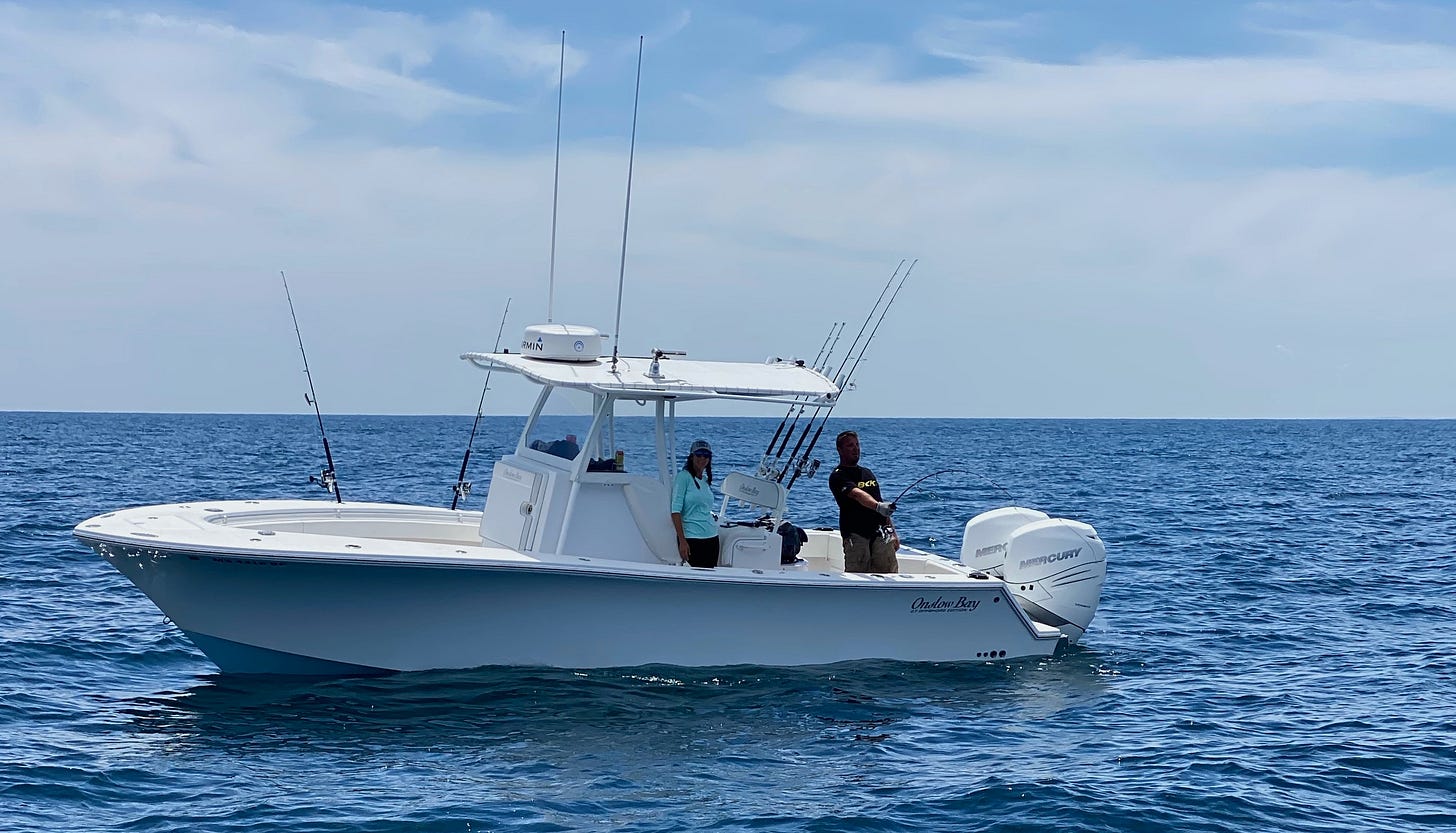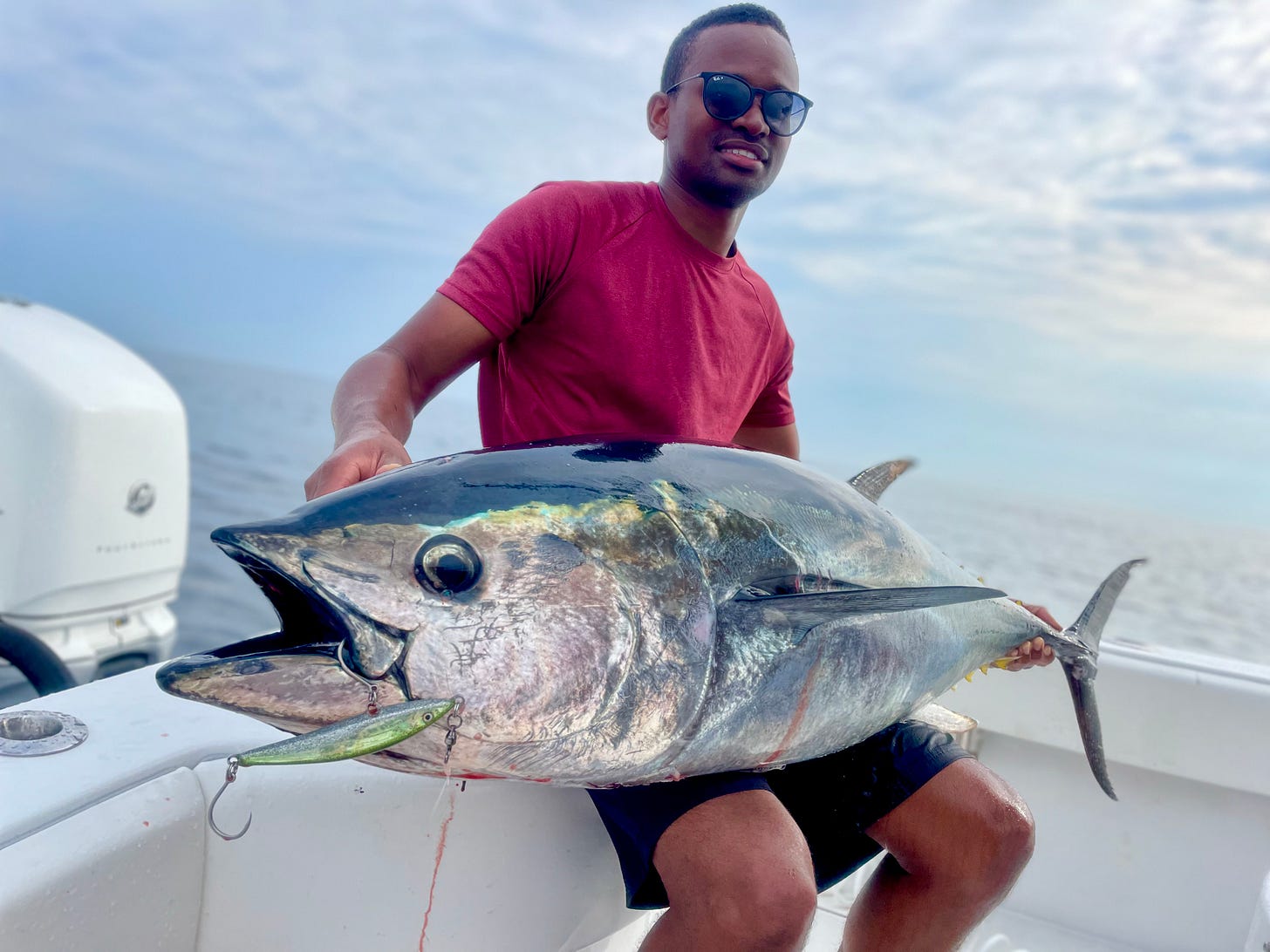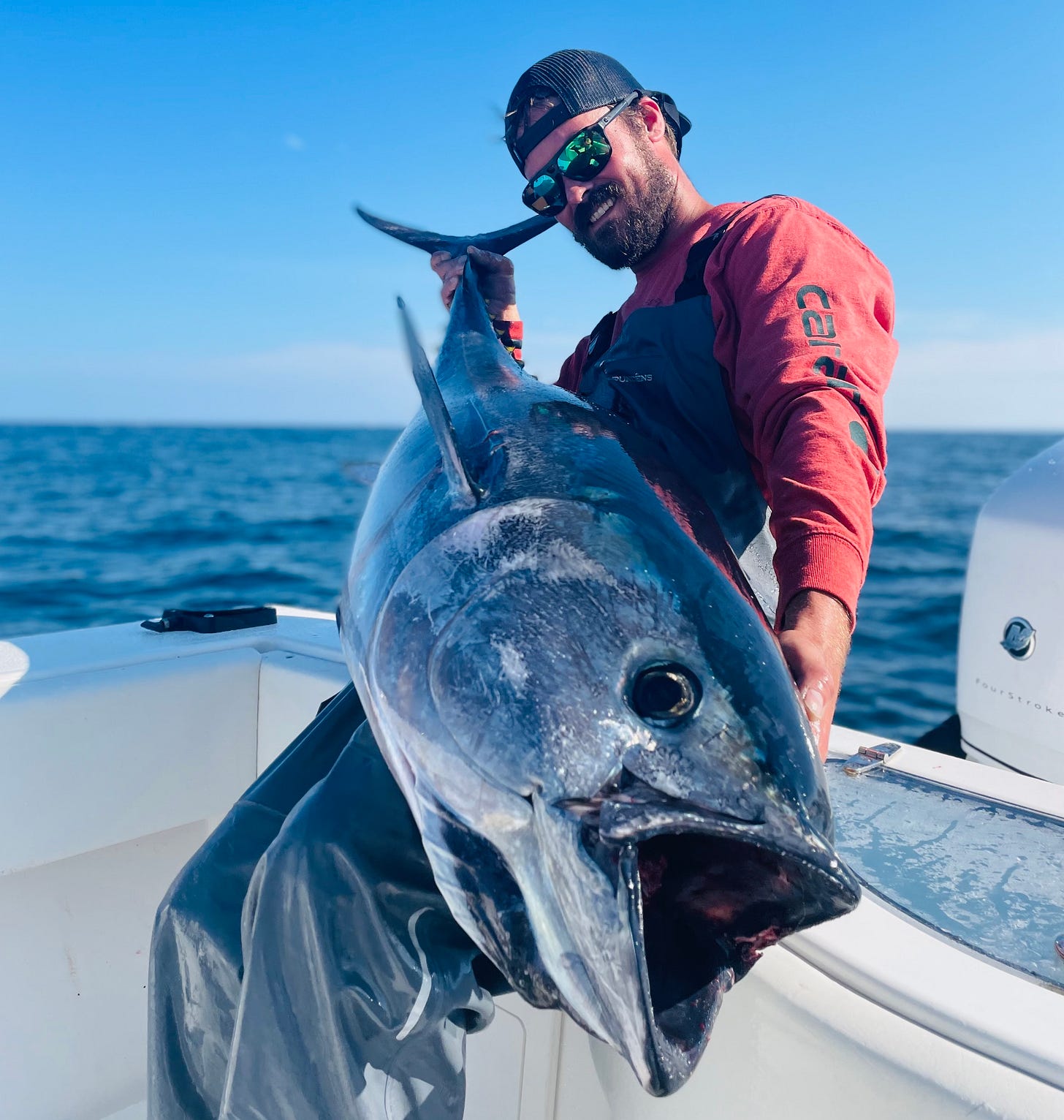The maritime law of salvage has its origins in Roman law, which dictated that one who preserved or improved upon the misplaced property of another was owed compensation, even if the service was not requested. Let’s get out the inter-webs seiner and get to work…
Podcasts of the Week: The Saltwater Euphoria Podcast: Highly Migratory Species Tagging Studies with Walt Golet —> Fish tagging studies tend to get a bad wrap in my experience. Either the results are seen as unreliable (due to methodology/technology), represent too small a sample size to take for granted, or simply portray randomness. In a pursuit defined by pattern recognition, few of us want to be told we’ve been chasing ghosts. This podcast does a great job of casting a ‘high-level’ view of multiple tracking studies, explaining the limitations of the (early-stage) data, and then drawing a mental image of the BFT migration and ‘3-stock model’. I provide a very rough illustration (below) of the interaction between the Mediterranean spawning stock, the “Gulf” stock that spawns across a range encompassing the Bahamas, Yucatan and parts of the Caribbean Sea…and lastly, the ‘Sea-Slope’ stock that is alleged to spawn along the continental shelf off the East Coast. With my regional bias obviously showing, I’m fascinated at the prospect of 3 distinct stocks of tuna swimming through Cape waters, while Golet’s anecdote that individual fish have been tagged returning to identical coordinates year-over-year would suggest my seasonal logs might not be worthless after-all.
Bass-U Podcast: Josh Jones - Big Bass Specialist —> (skip to the 19-min mark if you don’t feel like being assaulted by ads for enlarged prostate treatments) —> It’s pretty much accepted that Josh Jones is the greatest big-bass fisherman of this new decade, having become the first angler to record four 13+lbers (all in Texas). His tactics sound simple but will be hard to replicate, and he certainly owes a lot of his success to being an early-adopter of FFS (forward-facing sonar). His recipe for trophy largemouth is as follows: 1) he thinks that true giants are most willing to eat in upper-30 to lower 40-degree water temps 2) he likes to target fish in 15ft+ of water, usually when they are suspending or chasing bait in open water (not structure-oriented) 3) he only throws 2 baits in the winter-early spring - an Alabama Rig or Swim-jig (3/8oz head in natural colors with no trailer!) 4) he likes to fish low-light periods and 5) is “totally OK” fishing for one bite a day. Easier said than done.
Fishing Reports: OnTheWater / Fisherman Mag / SaltyCape / HullTruth / 360Tuna
***Reminder to renew your fishing licenses here.***
Local Knowledge: Welcome to the 52nd Weekly Salvage. What started off as a way to hedge against seasonal depression and make fun of people with SaltLyfe stickers has turned into something greater than the sum of its parts. It’s honestly been a goddamned privilege to share with, learn from, and go down the occasional internet rabbit-hole with you all. Almost exactly one year ago, I sat down for a particularly rowdy Zoom interview with Cohen Babcock (Southcoast Sporfishing) and Matt Perachio (Tighten Up Charters), which ultimately spawned the OTW article Ghosts of Chatham Fog, which in a way put the ‘Salvage’ on course. This week, we recaptured some of that glory with Matt, diving a little bit deeper into some of the topics the original article discussed. While we didn’t have time to delve into Perachio’s thoughts on PA-plate Subaru-driving SaltLyfers (maybe best left unsaid), he did give up some ‘juice’ on his most productive baits and tactics from 2022.
Q - Tuna fishing is all about balancing analytics and intuition: what was a scenario from 2022 where you made a difficult decision that ended up paying off?
A - I recall a stretch of a few days this past Summer when we had roving pods of fish just north of Nauset, generally active but just not super concentrated. We had to run through a lot of dead water to get there, and alongside 2 buddy boats from the north, we hadn’t really seen anything interesting on this particular morning. Around 11am, with just a random jig bite to show for our efforts, I had a gut feeling that we’d find something better closer to home. I honestly had no reason to suspect it, but halfway back to the Race, I saw a splash way inside (in the shallows) and went to investigate. Within 15 minutes we had bird signs and then tuna firing in every direction, airing out and blasting bait for a half-mile. And we were all alone. Within an hour, we were throwing hook-less plugs just to watch the show, everyone’s arms about to fall off.
Q - We spoke a good deal last Winter about harmonics (rpm, propeller pitch, boat weight) and tuna behavior…has the increased fishing pressure the last few seasons changed the way you approach feeds?
A - Over the past couple seasons we’ve been quite lucky to have what I’d consider a very spread-out topwater bite. Topwater scenarios are really when the harmonics of your boat and errant prop noise can alter tuna behavior. The only concentration of boat pressure we really had last year was the east of chatham jig bite. I don’t think the harmonics from motors and hull splashes really bothers tuna as much in deeper water, but sonar pings and fishing pressure (lures, fish being hooked) certainly does. I think when fish are on the fence about feeding, such a tight concentration of boats and sonar interference can definitely turn them off. I could be dead wrong, but usually after a super-crowded day or two, the fish seem more apt to ghost. It’s not like we’re marking them and they’re lock-jawed, they’re just gone, usually popping up somewhere not too far away.
Q - Almost everyone with a bit of tuna experience has worked with a ‘buddy boat’ on the grounds from time to time. In what type of situations has it been most effective for you?
A - Buddy boats are essential to finding fish in a timely manner. The key is knowing who you are working with. Are they experienced? Do they have the same thought process as you? For example…ever get this text?
Then you run 3 miles and see nothing when you arrive…
Left on read…This is a scenario that plays out all the time. If you hadn’t seen a fish all day, then maybe it wasn’t a terrible move, but you most likely just wasted an hour of your morning chasing ‘un-catchables’.
The best charters have a tight network and know how the other captains think. There are certain guys that tell me “get here now” and its just second-nature to get my lines in and hammer down. When the intel and source are right, it saves us time, fuel, and I can say from experience that customers love being connected to a network for the day.
The perfect scenario is we’ll split off in the dark and never even see each other until we converge on fish that one of us located. As long as everyone is forthright and busting their butt (and gas bill) to find fish, it’s a system that works like a well-oiled machine. The “buddy” boat that sits back, sips fuel, and waits for the rest of us to find ‘em will eventually find themself out of the lineup.
Q - What were your most productive baits during the 2022 season? And what has a greater impact on lure choice: weather conditions, forage, or the size of the fish you’re targeting?
A - Personally, my top lures were the Siren Antidote 130, Hogy Pro Tail, Diawa Dorado Slider, Hogy Sand Eel and Point Jude Deep Force Jig. My lure choice really comes down to how the tuna are feeding. And how they’re feeding usually depends on bait. Butterfish and rain bait are slow lethargic feeds, while Sandeels and halfbeak boils typically produce more concentrated and aggressive patterns. In the case of the latter, a tuna’s willingness to hit a wider range of lures is simply due to the confusion of the blitz, while slower feeds give the fish a chance to be more opportunistic and less reactive.
—> For those looking to learn more from Capt Perachio and a bunch of the Northeast’s sharpest pelagic and billfish minds, consider attending the Castafari Offshore Fishing Seminar later this month (February 25 & 26, 2023 • Marriott Hotel, Quincy, MA)
Lipless Crankbaits for Early-Season Largemouth (LureNet) —> With Springtime bass fishing on the near-horizon in the Northeast, this article really wets the appetite for some good-ole fashioned lip-rippin’. Besides jerkbaits and bladed-jigs, the lipless crankbait rounds out my top-3 for the most productive ways to get on the board in a fledgling freshwater season. The lure category really shines because a) its super versatile in the water-column b) you can fish it at a ton of speeds and cadences with the right size/line choice and c) its got a combination of flash and vibration that can draw vicious strikes from a better class of fish. Once the water temps crack 38-degrees, a medium-to-slow bottom-contacting retrieve is my go-to around submergent grass and gravel. Once the ‘pre-spawn’ really gets going, a yo-yo presentation over weedy flats and wind-blown banks really fires em up.
Bucket-list Fishery: Wintertime Yellowfin in Venice Louisiana (SaltwaterSportsman) - “The Midnight Lump, also labeled the Sackett Bank on some marine charts, is the top of a large underwater mountain that comes within a couple hundred feet of the surface. To get there, run about 50 miles southwest of the Louisiana coast. The combination of shallow water (depth ranges between 200 and 250 feet) and large schools of baitfish that get caught in nearby currents is what makes fishing on the Lump so great. The underwater, mountainous paradise serves as a major feeding location. Some of the largest wahoo and tuna on Earth aggregate here to feed.”
Top 20 Tuna / Striper / Freshwater Lures of 2022: Based on feedback from the latest ‘suggestion box’, we’re going to highlight our most effective baits and presentations from the past season, ranking baits based on effectiveness, durability, price, and uniqueness.
#18 - RonZ HD 3oz (8”, 3oz, Olive, $15) —> Not to be confused with its giant-bluefin smashing older brother, this finessey offering sometimes gets over-looked in rec-tuna and Striper capacities. Its still got a stout enough hook for the finicky Butterfish munchers (I like to trim down the tail to ~5”), and is heavy enough to keep consistent bottom contact when drifting rips and rocks looking for big bass.
#17 - Beast Coast Miyagi Swimbait (4.75”, Natural Shad, $8/3-pack) —> Another multi-species weapon with freshwater origins and wicked sweet mech-poured designs. Slow-roll it in March on a 1/2oz swimbait head for pre-spawn smallies, put it on a 6/0 Owner beast hook in April for staging largemouth around stumps and veggies, and then put it on a 1.5oz jighead for Stripers in Buzzards Bay in late May. Swiss-army knife of bass destruction.
Thanks for reading The Weekly Salvage, until next week!
Follow us on IG @Blowin_We_Goin













